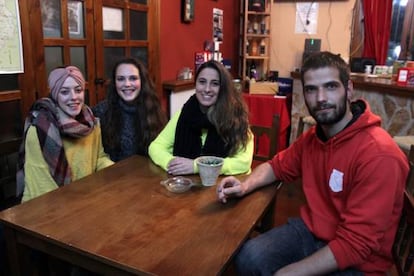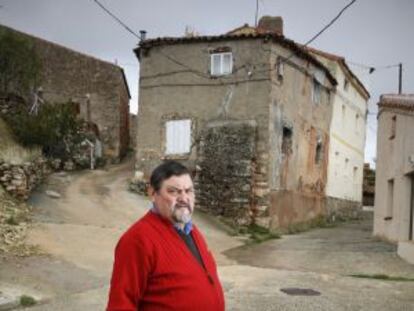This is what it feels like to be a youngster in Spain’s most deserted area
Mountain region between Guadalajara, Teruel and Cuenca has a lower population density than Lapland
To reach Peralejos de las Truchas from Madrid you need to take the road pictured below. The other way into town, from the road to Cuenca, is not much better.

Peralejos is located in an area that borders the provinces of Guadalajara, Cuenca and Teruel, known as los Montes Universales. It is the least-populated part of Spain, not to mention one of the emptiest regions in all of Europe. The population density in Montes Universales (1.63 inhabitants per square kilometer) is even lower than in Lapland, the coldest region of Finland (1.87).
The school has a classroom that is shared by children ages three through 12. The doctor comes in three times a week, there is no Civil Guard station, and the internet connection acts up all the time. The nearest hospital, university, nightclub and movie theater are nearly a two-hour drive away.
Yet this is the place that Gonzalo Moreno, 23, Lidia Menchero, 21, Yoli Moreno, 18 and Andrea Martín, 18, call home. They are the only residents of Peralejos aged between 18 and 25.
“Peralejos is dead, but what can we do?,” says Gonzalo, sitting inside a local bar. Julia, Yoli and Lidia agree. So does the waiter, and also Gonzalo’s father, who provides the demographic data: “There are 110 permanent residents in the village, although 170 people are registered.” Around 70 years ago, the population was close to 700.

Each one of these youths has a different background. Gonzalo moved to the city of Guadalajara in 2012, and lived there until May 2017. He studied, worked in the logistics sector, and returned home when his last contract ended. He now works at a rural B&B run by his family.
Lidia also left to pursue studies in Zaragoza, but soon moved back in with her parents due to the poor job prospects. She wants to leave Peralejos again to enroll in an early education teachers program.
Julia and Yoli have never lived anywhere other than Peralejos. In September, the former will move to Cuenca to study to be a dental hygienist, while Yoli is already working at a supermarket thanks to her brother’s connections
After completing their primary education, they attended the nearest high school in Molina de Aragón, a 40-minute drive by car. Most of their fellow students have since moved to other parts of Spain.

Lidia is still trying to pass a few high school subjects that she left on hold when she moved to Zaragoza. She is also working. “I earn peanuts. I watch over the kids who take the school bus,” she says, alluding to the vehicle that takes high school students to Molina each morning, making stops in other villages. This bus is also the sole public mode of transportation for other residents in the area, who call up the bus company whenever they need a ride. It takes one hour to cover 50 kilometers.
“People here made a living from agriculture and livestock. But now you can’t even think about it because of intensive farming. We have a friend who has sheep, and it’s nearly impossible for him to get ahead,” says Gonzalo.
His brother Fernando, who lives in Guadalajara where he is training to be an ambulance driver, explains: “It’s a vicious circle. If the services didn’t leave first, people wouldn’t leave. If there were more people, there would be a school for Lidia to work in, and a dentist for Julia to work for.” Fernando hopes to return to Perajelos when he gets his diploma, because “ambulances are needed everywhere.”
Fun in Peralejos
Fernando returns home every weekend. Also here today is Andrea Esteban, who lives in Guadalajara but drives over to her father’s home village every Friday. “There are around 11 or 12 of us here on weekends, although on weekdays there’s just five.”
Solutions for depopulation
Asked for solutions to depopulation, several locals suggested a similar fiscal status to the Canary Islands. “Give people tax breaks, and watch them come. Watch the companies come,” says Gonzalo.
Zaragoza University prehistory professor Francisco Burillo, a specialist on depopulation and president of the local association Serranía Celtibérica, agrees. He says villages like Peralejos are fated to disappear. According to National Statistics Institute data, 32% of residents of the Montes Universales area are over 65 years of age, and only seven percent are under 15.
“There is a uniform area encompassing parts of La Rioja, Burgos, Soria, Segovia, Zaragoza, Teruel, Guadalajara, Cuenca, Castellón and Valencia where depopulation is a very serious problem,” he said. This area is twice the size of Belgium.
In 2015, his association drafted a project to halt depopulation that included tax incentives for businesses and transportation subsidies for residents, like island populations have. A mixed Congress-Senate committee passed a non-binding motion, “but no progress has been made.”
For fun, they stay right here in Peralejos. “Have you seen what the road is like? Are you really going to drive 40 minutes to have a drink, then get stopped by the Civil Guard?” asks Gonzalo. “I think that’s a positive thing about being so far away: you stay in the village. If we were any closer to Molina, we’d go there more often.”
Lidia explains the ritual. “On Friday afternoon I call Yoli and then Gonzalo. A beer on Fridays and Saturdays is sacred. It’s always the same. You don’t plan ahead, but it could also be the night of your life, even if there’s just 10 of us.”
They usually meet at one or another of the local bars, but once a month they have a special night: “The town officials let us use a space with a heater so we can throw parties. We even have a futbolín [table football],” notes Yoli.
But summer is the time when things really liven up: that is when villages in the area start holding their local fiestas. This is their favorite season, and not because the weather is warmer (this is, after all, one of the coldest regions in Spain) but because the village fills up with people.
“In the summer we get people from all over Spain, but especially from Madrid, Barcelona, Guadalajara, Zaragoza and Valencia. They return to the village,” says Gonzalo. These émigrés are often joined by their own children. During the summer months, there are up to eight bars operating in Peralejos. “If it were like summer all year round, I would not want to leave,” says Lidia.
City life, village life
Like other youths, these youngsters are hooked on social media, with the younger ones preferring Instagram and the older ones Facebook. They go to the beach on holidays, watch more series on Netflix than they do on TV (despite the connection issues), buy their clothes at Zara and have more progressive views than their parents. But some things are different.
“If there are just four people your same age, you can’t afford to be getting into fights,” says Lidia. If love is involved, things can get even more complicated, “but you need to adapt. If you have a fight with somebody, you just don’t look at them anymore. I don’t miss meeting new people.”
Asked if they think of ever raising children in Peralejos, Yoli and Lidia have different ideas. “If I keep working at the supermarket, of course, there is no doubt about it. I’d love to,” says Yoli.
“I can’t imagine it, really. The way things are, I don’t think I could,” replies Lidia. And so the most underpopulated area of Spain keeps getting emptier.
English version by Susana Urra.
More information










































